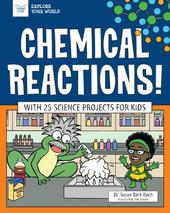
|
Chemical Reactions!: With 25 Science Projects for Kids
Hardback
Main Details
| Title |
Chemical Reactions!: With 25 Science Projects for Kids
|
| Authors and Contributors |
By (author) Susan Berk
|
|
Illustrated by Tom Casteel
|
| Physical Properties |
| Format:Hardback | | Pages:96 | | Dimensions(mm): Height 254,Width 203 |
|
| ISBN/Barcode |
9781619309418
|
| Classifications | Dewey:540 |
|---|
| Audience | |
|---|
|
Publishing Details |
| Publisher |
Nomad Press
|
| Imprint |
Nomad Press
|
| Publication Date |
9 June 2021 |
| Publication Country |
United States
|
Description
Age range 6 to 9 Chemical Reactions brings chemistry to life with hands-on, science-minded activities and plenty of text-to-world connections that invite kids to discover the wonderful world of chemical reactions! Did you eat toast this morning? Did your family have a fire in your fireplace last night? Those are both chemical reactions! In Chemical Reactions! With 25 Science Projects for Kids, readers learn about the atoms and molecules that make up everything in our world and what happens when different atoms and molecules come in contact with each other. Hands-on STEM activities include exploring candy chromatography, making ice cream, and creating a hydrophobic tower.
Author Biography
Dr. Susan Berk Koch is an award-winning author of dozens of articles for children. Her work has been featured in magazines such as Highlights, Muse, Odyssey, Boys Quest, and Ask. She has a B.S. in biology and chemistry, and her doctorate from Marquette University. Susan lives in Mequon, Wisconsin, with her husband, three boys, and a menagerie of pets. Tom Casteel is an illustrator and cartoonist who graduated from the Center for Cartoon Studies in 2011. He has illustrated more than two dozen books for Nomad Press. Tom lives in South Bend, Indiana with his wife, son, two smelly dogs and one old cat.
ReviewsPraise for Explore Atoms and Molecules! With 25 Great Projects Booklist Spotlight Atoms and molecules certainly cannot be seen with the naked eye, but that doesn't mean that budding scientists cannot learn about their properties in observable and interactive ways. Slingerland utilizes an inquiry-based approach to studying the building blocks of matter, positing questions to readers that serve as the basis of each experiment and encourages young scientists to keep a notebook recording their hypotheses, observations, and conclusions. By conducting these experiments, young readers get a chance to observe even the most microscopic aspects of physical science.
|